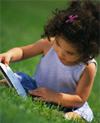 |
 |
 |


|
Once upon a time, there was a witch and a little girl with a red hood. Or maybe there was a dwarf, a princess, and an evil king. Or maybe two children, and a witch, and a scheming father. Or there might have been an orphan and a talking cat. At any rate, they all lived together in a house in the woods, until a catastrophe sent the young hero (in disguise, of course) out to find fame, fortune, and true love.
There are witches aplenty in Michael Gruber’s tale of The Witch’s Boy. There’s also a talking cat, several fairies, and a scheming father. But their lives, and the roles they play in the life of Lump, the witch’s boy, are so far removed from their more familiar stories that readers may forget they‘ve met these characters before. Lump passes most of the Grimm brothers’ canon in his journey, and many characters admit their participation in much-changed versions of the familiar stories. Attentive readers can see the shape of fairy tales to come even when Gruber doesn’t highlight them with key words. But these background stories are so altered from the originals that the connection between the two seems almost superfluous. Indeed, playing Spot the Fairy Tale sometime distracts from the more vibrant tale of Lump and his family. The game is justified by its connection with the tale’s inherent larger themes of masks and miscommunication; but however much Gruber might have been inspired by the old fairy tales, his own work exceeds the limit of the form and is only limited by attempts to echo the old stories.
The most notable departure of form is in the characters. In the works of Perrault, Grimm, and all their direct descendants, the plot is everything. Characters fill their roles of Witch, Princess, Trickster and Orphan with a bland uniformity that has spawned a thousand comparative folklore studies. Gruber’s characters are the story. Taken away from the fairy-tale setting, deprived of magic altogether, Lump would still struggle with his bitterness, Falance would be cocky as any cat, Mrs. Forest would struggle with the balance between work and motherhood. The feelings and struggles the characters face are universal, but their ways of facing them are always unique. Gruber forces his characters to realism through the rare process of allowing them to fail, not just in individual actions, but in their entire personalities. The Witch is not just busy and distracted; she’s touchy, oblivious, and willfully ignorant of her own failings. Lump, who as a mysterious and unjustly persecuted foundling is prime fantasy hero material, is instead ungrateful, callous, and realistically cynical. For all their failings, none of Gruber’s characters is ever unlikable. Every one inspires affection, and their many failings create the same sympathy as watching a child’s first struggles to walk.
Despite the trolls, talking cats, and even fairies, The Witch’s Boy is no fairy tale. It’s not even a fantasy. It’s a true story about people who walk our world every day, people who even live in our bodies from time to time. The Witch’s Boy is just a mask to help us recognize them.
|







|
| |
Sarah Meador/2006 for curled
up with a good kid's book |
|
|
For grown-up fiction, nonfiction and speculative fiction book reviews,
visit our sister site Curled Up With a Good Book (www.curledup.com)
|
|